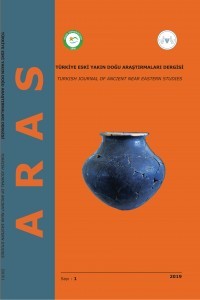Elazığ Müzesi'nden Bir Grup Fibula
Bu makalede Elazığ Müzesi’nde bulunan on adet fibula değerlendirilmiştir. Fibulalar müzeye satın alma yolu ile kazandırılmıştır. Bu nedenle buluntu yerleri ve durumları hakkında veri bulunmamaktadır. Çalışmada fibulaların kullanım alanları ve işlevleri ile üretim ve bezeme tekniklerine de açıklık getirilmeye çalışılmıştır. Bronz üretimi olan fibulalar döküm tekniğinde üretilmiştir. Yuvarlak kesitli fibulaların kolları üzerinde simetrik yerleştirilmiş silmeler ve toruslar yer alır. Torus ve silmelerin sayıları iki ile üç arasında değişir. Eserlerin kilit yuvaları bir dörtgen plakanın dövülerek el formunda bükülmesiyle oluşturulmuştur. Nitekim fibulaların çoğunluğunda kilit yuvasında parmaklar belirgin işlenmiştir. İğneyi oluşturan tel ise gövdenin bir ucuna iki veya üç kez sarılarak kullanılmıştır. Eserler gövde yapılarına göre üçgen ve yarım daire olmak üzere sınıflandırılmıştır. Çalışmada fibulaların tarihlendirilmesinde benzer örneklerden yararlanılmıştır. Böylelikle Elazığ Müzesi fibulaları M.Ö. VIII.-VII. yüzyıllara tarihlendirilmiştir. Elazığ Müzesi’nde sergilenen fibulaların elbiselerin uçlarını birleştirmenin yanı sıra kemer ya da kuşaklarda aksesuar olarak kullanıldığı önerilebilir. Bu makalede incelemiş olduğumuz fibulalar bilinenlere yeni katkılar sağlaması açısından önem arz etmektedir.
Anahtar Kelimeler:
fibula, urartu, assur, elazığ müzesi, giysi
A Group of Fibula from Elazığ Museum
In the article, ten fibulae found in Elazığ Museum were evaluated. The fibulae were brought to the museum by purchasing. For this reason, there is no data on their finding places and conditions. In the study, it has also been tried to clarify the usage areas and functions of the fibulae and the production and decoration techniques. The fibulae produced in bronze were produced by casting technique. There are symmetrically placed ridges and toruses on the arms of the circular-sectioned fibulae. The number of torus and ridges varies from two to three. The lock slots of the pieces were formed by forging a rectangular plate and bending it in the form of a hand. As a matter of fact, the fingers are clearly engraved in the lock slot in the majority of fibulae. The wire forming the needle was used by wrapping two or three times on one end of the body. The pieces are classified as triangular and semi-circular according to their body structure. Similar examples were used in the dating of fibulae in the study. Thus, the fibulas of Elazığ Museum were dated to the VIIIth-VIIth centuries BC. It can be suggested that the fibulae exhibited in Elazığ Museum were used as accessories for belts or sashes, as well as joining the ends of the dresses. The fibulae that we have examined are important in terms of providing new contributions to the known.
Keywords:
fibula, urartu, assyrian, elazığ museum, clothing,
___
- Belli 2010 O. Belli, Urartu Takıları, İstanbul.
- Bilir 2019 A. Bilir, “Bronz Fibulae of the Bolu Museum”, CEDRUS, VII, 77-105.
- Bilir 2020 A. Bilir, “Kocaeli Müzesi’nde Bulunan Bir Grup Fibula”, Karadeniz Araştırmaları Enstitüsü Dergisi, 6/9, 23-34.
- Curtis 2013 J. Curtis, An Examination of Late Assyrian Metalwork with Special Reference to Nimrud, Oxbow Books, Oxford and Oakville.
- Çavuşoğlu – Gökce-Işık 2014 R. Çavuşoğlu, B. Gökce, K. Işık, “The Craftsmen and Manufacturers in the Urartian Civilization”, Anatolica, XL, 23-45.
- Erdan 2017 E. Erdan, “Aydın Arkeoloji Müzesi’nden Bir Grup Frig Tipi Fibula”, Arkeoloji ve Sanat, 157, 51-60.
- Gögtaş – İgit 2019 N. Gögtaş, İ. İgit, “Ahlat Müzesi’nde Bulunan Urartu Dönemi Madeni Takılar, Bingöl Üniversitesi Sosyal Bilimler Enstitüsü Dergisi, 9/17, 535-552.
- Mcintosh 2005 J. R. Mcintosh, Mesopotamia New Perspectives, Santa Barbara.
- Muscarella 1964 O. W. Muscarella, “Ancient Safety Pins”, Expedition, 6/2, 34-40.
- Muscarella 1965 O. W. Muscarella, “A Fibula from Hasanlu”, AJA, 69/3, 233-242.
- Muscarella 1967 O. W. Muscarella, Phrygian Fibulae from Gordion, London.
- ISSN: 2651-4788
- Yayın Aralığı: Yıllık
- Başlangıç: 2019
- Yayıncı: Iğdır Üniversitesi
